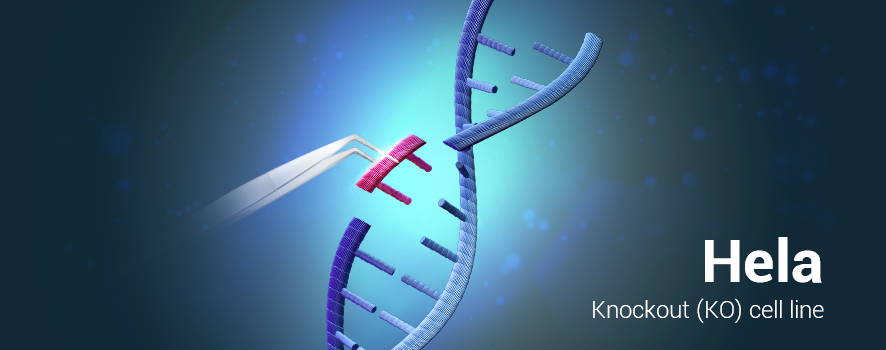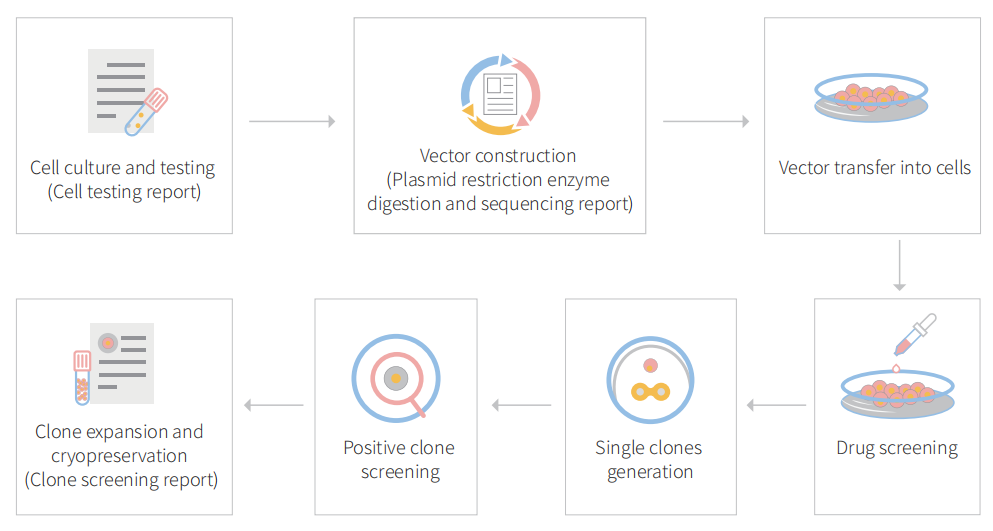
Introduction of HeLa cells
HeLa cells, like other cell lines, are termed as an immortal cell line used in scientific research, which can divide an unlimited number of times in a laboratory cell culture plate as long as being they are maintained and sustained in a suitable environment. It is commonly applied in gene-editing research, where HeLa cells become CRISPR/Cas9 KO cell line.
HeLa cells are the oldest and most commonly used human cell line, as well as the most frequently-used CRISPR cell line. The line was originated from cervical cancer cells of a 31-year-old African-American woman in 1951. The cells from this cell line were observed that they grew very fast and doubled every 20-24 hours, unlike other specimens that died out previously. This cell line was found to be remarkably durable and prolific, which causes it to be used widely in scientific study, such as HeLa knockout cell line.
Application of HeLa cells
Since HeLa cells were the first human cells to be successfully cloned in 1953, they have continually been used for research into cancer, AIDS, the effects of radiation and toxic substances, gene mapping, and countless other scientific pursuits. For example, HeLa cells were used by Jonas Salk to test the first polio vaccine in the 1950s which made HeLa cells highly desirable for polio vaccine testing since results could be easily obtained. Moreover, HeLa cells have also been instrumental in the development of Human papillomavirus (HPV) vaccines.
In 1965, Henry Harris and John Watkins created the first human-animal hybrid by fusing HeLa cells with mouse embryo cells. This enabled advancements in mapping genes to specific chromosomes, which would eventually lead to the Human Genome Project, involving gene knockout and gene knockin by CRISPR technologies.
1) Establishment of SQSTM1/p62 gene knockout Hela cells by CRISPR/Cas9
To explore the efficiency of CRISPR/Cas9 gene-editing directed against p62 double sgRNA, researchers have successfully used CRISPR/Cas9 gene-editing technology to knock out the p62 gene. The cell dilution method and puromycin screening were also applied to separately confirm the success rate of double sgRNA and single sgRNA guided gene editing. Western blot analysis showed that double sgRNA-directed p62 knockout efficiency was higher than single sgRNA-directed knockout. Target-sequence sequencing analysis suggested that the p62-encoding gene had large deletion mutations. The result of stable knock-out Hela cell line after H2O2 treatment showed that p62 gene knock-out can significantly inhibit the early apoptosis induced by H2O2 in Hela cells. Therefore, the p62 knockout Hela cell line has been successfully established. The double sgRNA-guided CRISPR/Cas9 gene-editing system may be a more effective editing tool.
2) Construction of stable Cdc25C knockout HeLa cell strains using CRISPR/Cas9 gene-editing system
The CRISPR/Cas9 gene-editing system was used to knock out the cell division cycle 25 homolog C (Cdc25C) gene in human cervical cancer cell HeLa to construct a Cdc25C gene stable knockout cell line. The method was based on CRISPR/Cas9 target design rules, design small guide RNA (sgRNA) upstream and downstream that specifically recognize the relevant sequence of the first exon of the Cdc25C gene, construct a eukaryotic recombinant expression plasmid. After sequencing and identification, the recombinant plasmid is transfected to In HeLa cells, puromycin (puromycin) resistance screening was used to stably knock out the Cdc25C gene cell line, and then Western blotting was used to identify the Cdc25C knockout effect. Finally, flow cytometry was used to detect the effect of gene knockout on the cell cycle. Results The cell lines with stable knock-out of the Cdc25C gene were screened, and Cdc25C knock-out significantly affected the G2/M phase process. Conclusion The endogenous Cdc25C gene knock-out cell line was successfully obtained using CRISPR/Cas9 technology to study the function of Cdc25C in the cell cycle process And the occurrence of related cancers has laid the foundation.
Work flow of knockout HeLa cell line

Figure: CRISPR-U™ customized workflow for engineered HeLa model cells
Ubigene developed CRISPR-U™ which optimizes eukaryotic cells and animal gene-editing vectors and process. The efficiency and accuracy are 10x higher than traditional methods. Contact us immediately to know about your research related services!
Reference:
5 Contributions HeLa Cells Have Made to Science. Cell Science from Technology Networks. Retrieved 2020-03-25.
Yao Ye-bao, Wang Guang-fei, Dong Qing-cai, Cao Cheng. Construction of stable Cdc25C knockout HeLa cell strains using CRISPR/Cas9 gene-editing system, Military Medical Sciences, 2019,42(1):1-5.
Huang Rongfu, Peng Weilin, Lin Jiansheng, Lian Jianfeng, Yang Xiaoyu, Zheng Ming. Construction of stable Cdc25C knockout HeLa cell strains using CRISPR/Cas9 gene-editing system. Military Medical Sciences, 2017,41(5):359-362
 Subscribe Us
Subscribe Us Gene Editing Services
Gene Editing Services
 EZ-editor™
EZ-editor™ Red Cotton Gene knockout Project
Red Cotton Gene knockout Project









